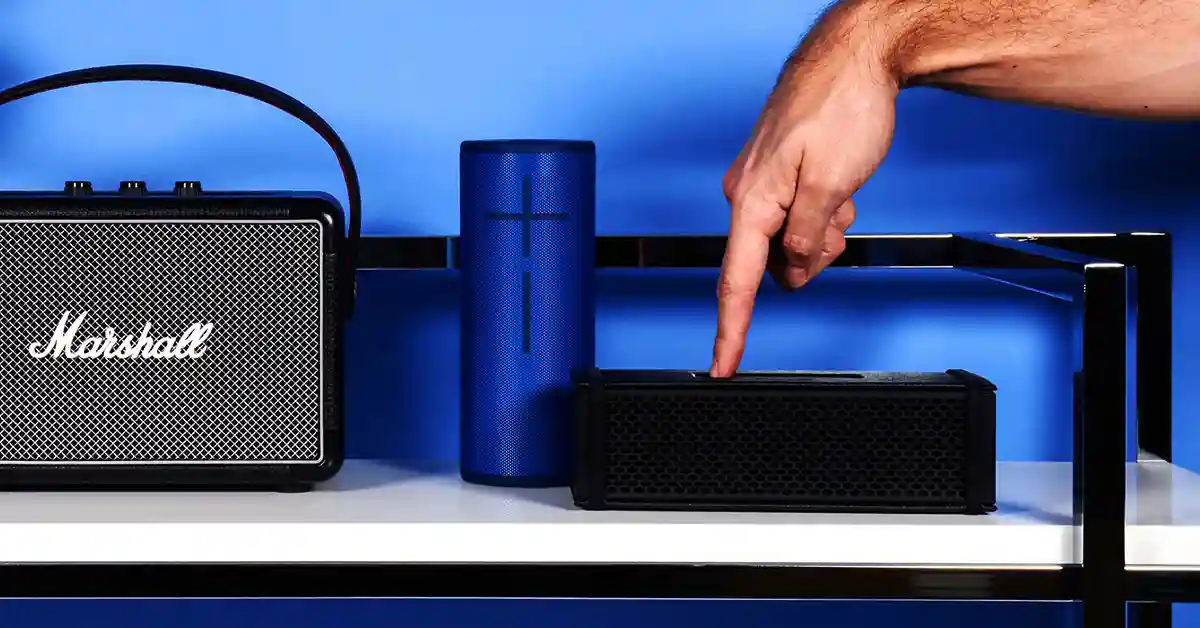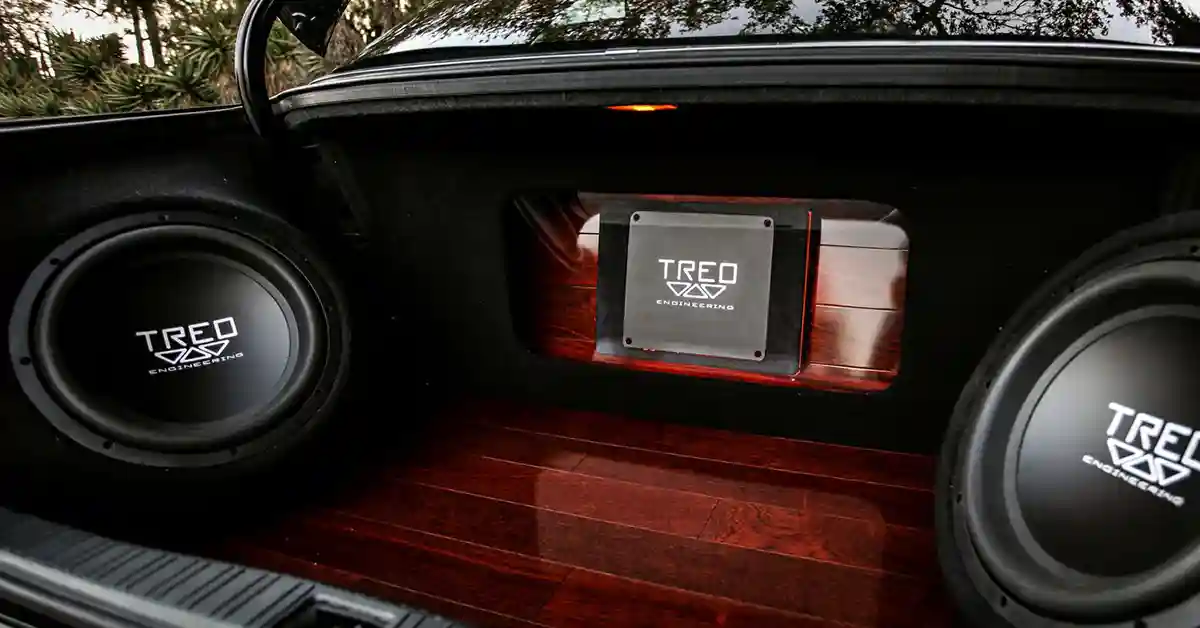Speaker Magnets: What Do Magnets In Speakers Do?
Speakers have magnets in them because they help produce sound using electromagnetism.
Magnets inside a speaker create a varying magnetic field when exposed to electric current. This creates an electromagnetic force that forces the speaker's driver to move back and forth. Because the driver is attached to the speaker's cone, it is subject to this same back-and-forth motion - creating sound waves.
Those sound waves are interpreted by your ears as music or sound.
With that, let's explore in more detail how speakers use magnets to produce sound.
Why Are There Magnets In Speakers?
Speakers are designed to convert electrical energy to sound energy, and magnets help them do this.
This is because speakers are tranducers, which are devices that convert energy from one form to another. When the speaker receives an electrical signal (also called an audio signal) this travels through the speaker's driver.
This electrical, alternating current (AC) passes through the speaker's voice coil and creates an electromagnetic force because of Faraday's law of induction, discovered by English physicist Michael Faraday in 1831. This causes the 'production of an electromotive force across an electrical conductor in a changing magnetic field.'
This electromagnetic force moves the speaker's driver back and forth, which in turn moves the cone surround (speaker diaphragm) that is attached to the speaker's driver. This movement then creates sound waves, which your ears and brain interpret as sound.
How Do Magnets In Speakers Produce Sound
Why do speakers have two magnets? Because, without two magnets in a speaker, there would be no ability to create a magnetic field - which in turn, allows sounds to be created.
Magnets produce sound in a speaker by creating a varying magnetic field, which produces a magnetic force that forces the speaker's cone back and forth to produce sound waves.
However, before we can understand this process, we need to understand how a speaker is assembled and the role of magnets inside it and how they work together to produce sound.
Detailed Explanation Of How Speakers Use Magnets
A speaker uses magnets in a unique way to produce sound.
Typically, a speaker has two magnets: a permanent magnet and an electromagnet.
The permanent magnet is usually round and cylindrical and looks a bit like a metal donut. They are usually made from one of three different materials - Alnico, Ceramic (Ferrite), or Neodymium. While Alnico has been used more traditionally in older speakers, a more modern alternative is Neodymium which is more powerful in smaller quantities. The permanent magnet is typically placed behind the speaker driver and is used as a backing to this part of the speaker.
The electromagnet of the speaker is the voice coil, as the voice coil becomes an electromagnet when an electric current is passed through it. The voice coil is just a coil of wire made from enamel-coated magnet wire, which is far better at creating an electromagnet force than regular wire can.
An electromagnet is formed because of the Lorentz force (or, electromagnetic force) which was discovered by the Dutch physicist Hendrik A. Lorentz in 1895. It says that if a wire is placed within a fixed magnetic field, a current that is passed through it will transform it into an electromagnet. This magnet will either be repelled or attracted, depending on the direction of the current that is passed through it - creating a force.

Because speakers use alternating current and electricity flows back and forth, this causes the electromagnet to move back and forth. The voice coil is typically fixed to the back of the speaker's cone, so this back-and-forth motion moves the cone and causes a series of sound waves to be produced.
Those soundwaves are received by your eardrums, which are then interpreted as sound by your brain.
How Do Speakers Use Electromagnets?
As mentioned above, speakers use electromagnets to create a varying magnetic field and force between the electromagnet (voice coil) and the speaker's permanent magnet.
An electromagnet is used because when an electric current is passed through it, an electromagnetic force lets it be suspended and move freely. Because it is fixed to the back of the speaker's cone, this back-and-forth movement allows the cone to produce sound waves.

These soundwaves are sent through the air and received by your eardrums, which are translated by your brain as sound and music.
Do Speakers Have Permanent Magnets?
Speakers usually have one permanent magnet, which sits at the rear (back) of a speaker. This exists to create a varying magnetic field with the speaker's electromagnet.
When current is passed through the electromagnet, it causes the driver to move back and forth - creating sound waves from the speaker's cone to which the voice coil is attached.

A speaker's permanent magnet is usually the larger magnet of the two used in a speaker driver.
What Does A Permanent Magnet Do In A Speaker?
A permanent magnet lets an electromagnet field be created in a speaker by being in close vicinity to the speaker's electromagnet. This creates the force that lets the speaker driver move, which is needed to produce sound waves which are interpreted by your ears as sound.
Speaker Magnetic Fields: How Do They Actually Work?
We've spoken at length about the magnets in speakers and what they do. However, how do speakers take an electrical audio signal and convert this into a range of tones for your ear to hear?
This explanation is quite scientific, so we will need to get into a bit of depth for it to make sense.
How Can A Magentic Field Be Produced In A Speaker?
A speaker is able to produce a magnetic field due to two components: its electromagnet, and a permanent magnet.
The speaker's electromagnet is what we call the voice coil, which is a thin piece of wire wrapped around a heat-resistant cylinder called a former. The wire that wraps around the former has a beginning and an end, both of which serve as terminals.
When an electric current is connected to these terminals, the current that runs through the tightly-wound voice coil creates what we call the electromagnet. This might sound something like magic, but it's due to a very specific scientific principle called Ampere's law.
Discovered by French physicist André-Marie Ampère in 1823, Ampère's law simply states that a current run through a conductor will produce a circular magnetic field around that conductor. Therefore, when the current is run through the voice coil, a magnetic field is produced around it. And, when there is no current, then no magnetic field exists.
At the same time, a large permanent (natural) magnet with a large center hole surrounds the voice coil.
This single magnet is a core component of electric loudspeaker design and has a backing and top plate on either side of it with a pole piece through the center. This pole piece is by design, and necessary to concentrate the speaker's magnet field through the gap so it interacts more powerfully with the electromagnet.
When the voice coil receives an input signal, in the form of AC current, it moves in synchronization with this current and creates a back and forth motion. As the voice coil is attached to the paper cone, it creates a series of a series of compressions and rarefactions that match the input signal.
This moves throughout the air, creating sound waves in alignment with these patterns. When these soundwaves hit your eardrum, they are intercepted and converted back into an electric signal - which your brain interprets as sound.
It's important to note that the 'bigger' these soundwaves are, the 'louder' they will be. This is explains why, when the volume is increased - which sends more current to the driver - the result becomes 'louder' because the speaker is able to move further and produce 'more' sound.
Electromagnetic Speaker Diagram
The below diagram explains how an electromagnet works within a speaker, and how it interacts with the speaker's permanent magnet. When a current is passed through the magnet, you can see how this creates a magnetic field through electromagnetism.

And furthermore, is the unique relationship between the electromagnet and permanent magnet, and how the speaker's coil moves freely and creates sound waves by being attached to the speaker cones.

Do All Speakers Use Magnets?
Not all speakers use magnets. However, the most commonly known speaker - a moving-coil dynamic speaker, relies on a permanent magnet and an electromagnet to produce sound.
According to Texas A&M University, the first loudspeakers produced in the 1800s only used two electromagnets because permanent magnets were too heavy and expensive to be used on a wider commercial scale.
In 1930, however, loudspeaker manufacturer Jensen produced the first speaker with a permanent magnet. After Alnico magnets were more easily manufactured after World War II, it was possible to produce permanent magnets at scale which meant they were quickly adopted in modern speaker manufacturing processes.
Can A Speaker Work Without A Magnet?
Although every speaker might not have the same type of magnets, it's difficult to find a modern speaker that works without electromagnet principles. This is because it makes commercial sense to produce speakers with magnets at scale in today's hi-fi industry.
However, there are speakers that use different magnet technology and don't necessarily use a moving-coil dynamic arrangement with an electromagnet, and a permanent magnet.
Are There Speakers Without Magnets?
There are other types of speakers that don't use magnets, like electrostatic and piezoelectric speakers. Additionally, newer inventions are starting to use innovative technology to produce sound - like MIT Media Labs Sonoflex speakers.
Let's explore some of those examples below.
Electrostatic Speakers
Electrostatic speakers produce sound with the help of a diaphragm that is placed between two mesh sheets.

The audio signal causes one sheet to pull and the other to push, moving the diaphragm back and forth to produce sound waves. A shorter traveling distance of the diaphragm causes far less distortion in sound, but this also means that electrostatic speakers are not great for bass and low-frequency sounds.

Because of this, speaker brands usually pair an electrostatic tweeter or mid-range speaker with a more common dynamic speaker as a subwoofer, a strong combination for high-end hi-fi quality sound. Due to their more complex engineering, electrostatic speakers often carrier a higher price than dynamic speakers.
Piezoelectric Speakers
Piezoelectric speakers (also known as piezo benders) use the piezoelectric effect, which uses pressure and/or heat to 'bend' materials.
These speakers apply a current to a piezoelectric material, causing it to move a diaphragm to produce sound. They are typically used in cheaper applications, like watches and other smaller electronic devices - and, sometimes for tweeters in less expensive sound systems.
As they are less applicable in a commercial loudspeaker market, they have specific use cases and are not often found in the most popular known hi-fi systems.
Experimental Speakers: MIT Media Lab's Sonoflex
On October 20, 2022 a group of professors from the MIT Media Lab introduced a prototype called Sonoflex which does not use a permanent magnet to produce sound. Rather, the design uses two embroidered flat spiral coils made from thin, isolated copper wire.
The design consists of two pieces of fabric that sit on top of each, each of which is custom embroidered with a spiral coil made from thin copper wire. When placed on top of each other, the coils act as a voice coil and a bias coil that are capable of creating varying magnetic fields and force when exposed to an electric current.

While the design is far from commercially viable on a wider level, it has resulted in some interesting use cases - including, being embroidered into clothes like jackets and beanies.
What Types Of Magnets Are Used In Speakers?
Speakers use two types of speakers: a permanent magnet and an electromagnet.
A speaker's electromagnet consists of a piece of wire wrapped around a core, also called a voice coil. This voice coil is usually made from enamel-coated wire, as it's far better at conducting electricity and forming an electromagnet than other wires are. A speaker's electromagnet, or voice coil, is not a complex magnet - it typically consists of a piece of enamel wire tightly wound around a cylindrical core.
A speaker's permanent magnet is a bit more complex than its electromagnet.
It is placed at the rear of the speaker, used as a backing to the speaker's core, and fixed to the speaker's backing plate. A speaker's permanent magnet is a cylindrical disc usually more than 0.5" in height. It is usually made from one of a few materials, these being Alnico, Ceramic (Ferrite), Neodymium, Samarium Cobalt, or, Bonded Magnets.
Let's explore these different types of speaker magnets below.
Alnico (AlNiCo)
Alnico was one of the first materials used to build permanent speaker magnets.

It is an alloy, meaning it's a metal that's man-made and comprised of a few base metals. Its name is derived from the metals from which it is made, these being aluminum, nickel, and cobalt - and, sometimes iron. These metals are merged together during the manufacturing process. Alnico is a good material for permanent speaker magnets because it's strong and less prone to cracking.
Musicians, sound engineers, and producers believe that Alnico speaker magnets provide a classic tone.
The downside of Alnico is that it can also lose its magnetism quicker than other materials, which leads to a reduction in sound quality in speakers. It is also more expensive to use because of its cobalt content, which is one of the most expensive metals to source and manufacture.
| Pros | Cons |
| Stronger than other magnets. | Loses magnetism faster than other magnets. |
| Less prone to cracking. | More expensive than other magnets, because of high cobalt content. |
| Audiophiles advocate it gives music a ‘classic’ tone. |
Ceramic (Ferrite)
Ceramic (also called Ferrite) magnets are newer and developed as a cheaper alternative to Alnico magnets. They are made from ferrite, a ceramic compound that is comprised of iron(III) oxide which is mixed with one or more additional metal elements.

Because they can use small quantities of various metals, they don't rely on a single base metal and are easier and cheaper to manufacture. They hold magnetism well over time, given that you don't expose them too closely to Neodymium magnets which will destroy their magnetism. The greater magnetism of Ceramic magnet speakers ensures that speakers that use them produce better sound.
The high iron content of ferrite makes it a heavier magnet type, so it is not an ideal choice for Bluetooth or portable speakers. However, for freestanding or loudspeakers - it can be a great choice. They should also be used with other speakers that use Ceramic magnets, as exposure to Neodymium magnetic fields can reduce their own magnetism.
| Pros | Cons |
| Compromised of various metals. | Heavier because of high iron content. |
| Easier and cheaper to make. | Magnetism is reduced when exposed to neodymium magnets. |
| Hold magnetism well over time. | Should only be used alongside other ceramic magnets to maintain magnetism. |
| Strong magnetism means better sound. |
Neodymium
Neodymium is a newer alternative to both Alnico and Ceramic magnets, and is one of the most popular materials for modern, moving-coil dynamic speakers.

Neodymium is a chemical element (symbol: Nd) and is considered one of the rare-earth metals. It is not found naturally in metallic form and needs to be refined for commercial use.
Neodymium is preferred because is it easier to magnetize and demagnetize, meaning that it can react quickly to electrical current changes that run through a speaker. This gives the voice coil a quicker response time, giving it a greater ability to produce greater frequency ranges than other magnets. It can achieve this even in smaller quantities, making it an excellent choice for both portable speakers and headphones. It can also handle temperatures of between 176°F and 446°F (80°C and 230°C), letting them be used for a range of commercial applications.
Neodymium magnets are not the cheapest, typically falling between Alnico and Ceramic (Ferrite) in terms of price. They oxidize quicker, producing pink, purple, blue, and yellow compounds when exposed to oxygen. Neodymium is also more sensitive than other magnets, making it more prone to shattering - which could lead to damaged speakers.
Neodymium speakers are one of the most popular types of speakers in today's market.
| Pros | Cons |
| Easier to magnetise, and demagnetise. | More expensive than Alnico and Ceramic magnets. |
| Reacts faster to electric current, producing better sound. | Oxidize quicker than other types of magnets. |
| High temperature threshold. | More sensitive than other magnets, increasing shattering risk. |
Samarium Cobalt
Samarium cobalt magnets are comprised of two rare-earth metals, Samarium and Cobalt.
They're typically a rarer type of magnet because cobalt is an expensive metal to produce. Magnets made from samarium cobalt can hold a steadier output in a magnetic field when temperature variations are introduced. They are also more resistant to corrosion and oxidization than neodymium magnets.

This makes them useful in extreme climate conditions and atypical environments like at sea and for marine applications.
As samarium cobalt is weaker than other rare earth metals, they are more brittle and likely to break when impacted. They are also much more expensive, meaning are they generally used in high-end industrial and commercial applications where they are specifically needed.
| Pros | Cons |
| Hold steadier magnetism even when temperatures fluctuate. | Rarer and more expensive to produce because of cobalt. |
| Can be used in extreme conditions. | Prone to shattering and breaking. |
| More resistant to corrosion and oxidization to neodymium. | Not commercially viable for most household products. |
Bonded Magnets
Bonded magnets are bonded by compression, and created by mixing a combination of different metals and alloys with binding materials like polymer. They are much easier to produce because they use lower-grade materials.
This means that they're unlikely to be used in speakers or commercial audio products like headphones because their lower quality does not justify them being used for consumer products.
However, they are used for lower-end speakers, audio products, and electronic devices and are worth mentioning because they are a good alternative to other magnet types.
| Pros | Cons |
| Easier to source materials, and manufacture. | Lack of purer metals makes them unsuited for high-grade consumer goods. |
| Cheaper than other types of magnets. | Cheaper quality might lead to quicker deterioration. |
FAQs
Does A Bigger Magnet Mean A Better Speaker?
A bigger magnet means that the speaker's driver can produce larger compressions and rarefactions, which can give the impression that a speaker is louder and therefore 'better'. However, this is a simple conclusion that rests on more complex factors than just the speaker's size.
It's important to also consider the materials used to create the speaker, such as the type of magnet.
Neodymium magnets can hold a lot more magnetism than other magnets, so it can be effectively used in smaller quantities to produce a better quality of sound. It might be smaller, but it uses much higher-quality materials which will make it better when compared to just a 'bigger' speaker.
Do Speakers Have Strong Magnets
Speakers can use incredibly strong magnets, in fact, they can use some of the strongest magnets in the world. However, it depends on what ‘strong’ means. Magnet strength is measured using maximum energy product, which is denoted as (BH)max.
Speakers are made with the following metals, the (BH)Max of which is listed below.
| Magnet Type | (BH)Max |
| Neodymium | 40 |
| Samarium Cobalt | 26 |
| Alnico (AlNiCo) | 5.5 |
| Ceramic (Ferrite) | 3.5 |
If you want to learn about the strength of magnets, follow this article for a breakdown.

What Is The Function Of Magnets In Speakers
As mentioned previously, there are two magnets in a speaker that produce a varying magnetic field between them.
By adding magnets to speakers they create a suspension that allows them to move freely next to each other. When current is passed through them in varying intervals, they move and create sound waves that are then interpreted as sound.
Learn more about the function of magnets in this section here.
Conclusion
Without magnets, speakers would not be able to produce the sound that they do.
While magnet technology has come a long way since the 1900s, the principle of magnets in speakers remains at a fundamental level, the same. As technology evolves and consumer demands become greater, there will no doubt be improvements and advancements in magnet technology in speakers.
Related Articles








